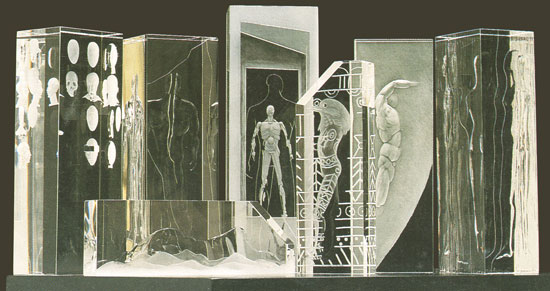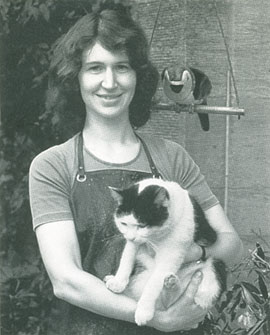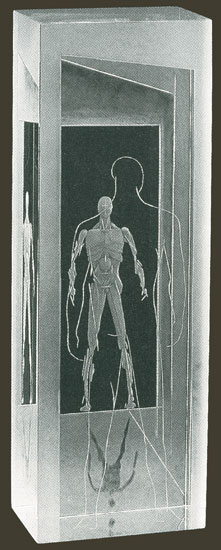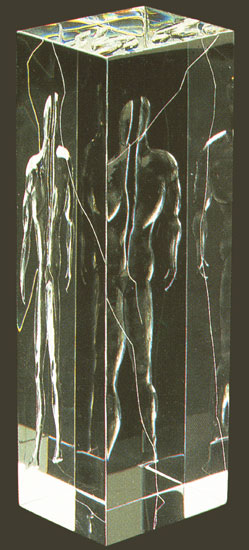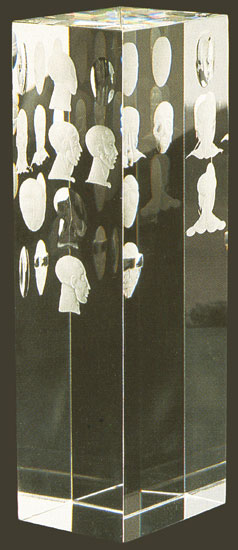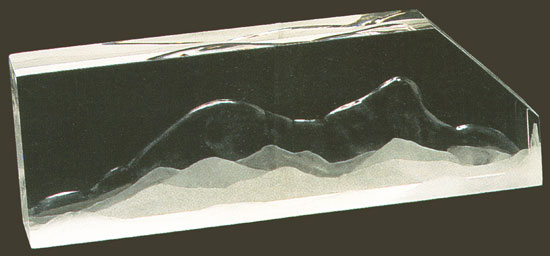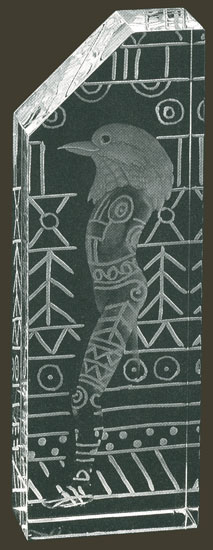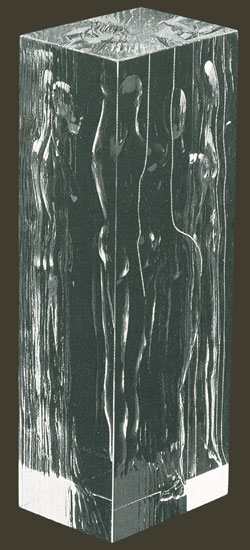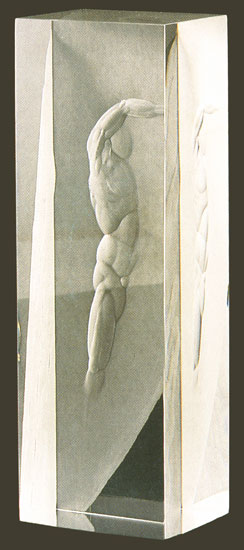Information and History
| Glass articles - Glass Makers and Artists |
COLERIDGELONDON’S CONTEMPORARY ART GLASS GALLERY192 PICCADILLY, WlTEL: 01-437 0106
Ring of Crystal, Ring of StoneEXHIBITIONBY THE SCOTTISH GLASS ARTIST AND ENGRAVERALISON KINNAIRDFROM 19th APRIL TO 15th JUNE 1988 |
||||||||||||
ALISON KINNAIRDB. 1949 Edinburgh. M.A. Celtic Studies and Archaeology at Edinburgh University. Studied glass engraving with Harold Gordon of Forres. Subsequently invited to attend special classes at Edinburgh College of Art by the late Helen Monro Turner. Working freelance since 1971 she has now gained an international reputation and is one of Scotland’s leading glass engravers. She is a member of British Artists in Glass and a Fellow of the Guild of Glass Engravers, and has served on the councils of both the Scottish Craft Centre and the Scottish Society of Women Artists. In 1979 she was selected by the Crafts Council for their Index of Craftsmen. In 1980 the S.D.A. and Crafts Consultative Committee awarded her a Crafts Fellowship. Her work may be seen in the collections of the Royal Museums of Scotland, Edinburgh City Museum and Glasgow Art Gallery, and in many private collections, including those of members of the Royal Family. She has exhibited her glass widely in many solo and group exhibitions. Alison is also recognised as the foremost exponent of traditional Scottish harp music, having given many concert recitals at home and abroad. Three records of her music have been released and have received critical acclaim. In 1984 she was invited to serve on the BBC’s Broadcasting Council for Scotland. She was awarded the Worshipful Company of Glass Sellers of London’s prize for artistic achievement in glass in 1987. She is married to Robin Morton, musician and record producer. They have two children. Ring of Crystal, Ring of StoneThis group of engraved crystal blocks was conceived as a circle of standing stones, and also as a visual interpretation of one of the classic forms of Scottish music. The circle may be read as a continuous line which begins and ends at the larger central block, or each piece may be taken on its own. Each comments on the human form or humanity in general, and each expresses something special about the nature of the glass. Several of the pieces of crystal show the use of prismatic reflection. The crystal blocks are cut at an angle which catches the natural light and reflects it in a full spectrum of colour. In some pieces the engraving on the facets of the crystal is also highly polished so that it, too, traps the rainbow colours. If these pieces are placed on a turntable in the natural light from a window, the moving facets throw many coloured reflections round the room. The MusicAlison Kinnaird is also widely recognised as the foremost authority on traditional Scottish harp music. She has produced a book of harp tunes which is the result of fifteen years of research into the old harp music and its historical background. She has also made three critically acclaimed records, and performed widely from Hawaii to Malaysia. She is well-known as a lecturer and teacher on the clarsach, the Scottish harp, and also composes for the instrument, including the music which was made especially for this exhibition. One of the important forms of traditional Scottish music is the development of a theme through several variations, returning to the theme again. This music is nowadays most widely known as the piobaireachd of the bagpipes - the “ceol mor” or “great music” of that instrument. It is regarded as the most difficult, but also the finest music to be played on the pipes. The clarsach, or Scottish harp, was the other ancient aristocratic instrument played, usually by professional musicians, at the courts of the kings and in the households of the Highland chieftains. It too used the theme and variation form for pieces of significance. They would be composed to mark special occasions - a lament for the death of a nobleman, a victory or defeat in battle, or a welcome to a great feast. This form of music seemed particularly appropriate to link with the artistic work in this case. The theme - a three-part melody - must be constructed so that the typically Scottish variations may be played on it. They do not relate to the variations which occur in classical composition. The main notes of the melody are taken and gradually decorated with progressively more complicated grace-notes, or are altered rhythmically so that the melody gradually re-emerges. Finally the theme is re-stated. The basic theme for the crystal is that of the human figure. No matter how it is split up, dismembered, decorated or disguised, the basic humanity will re-emerge in the end. The designs also contain references to the ways in which various cultures have dealt with the human figure - to Celtic, primitive and Renaissance art, to surrealism, myth and legend. |
||||||||||||
The TechniqueMost of the blocks of crystal are specially cut to the artist’s design. The crystal used contains up to 40% lead, which produces a material with particularly fine qualities of softness, clarity and brilliance. The technique is copper-wheel engraving, an intricate art that over the ages few have been able to master. The crystal is engraved with a small lathe which turns copper wheels on the end of spindles. Each wheel is of a different size and thickness and is filed to produce a "profile" - flat, round, oval or V-shaped - which will make a particular shape of cut when it touches the glass. The crystal is held in the fingers and applied to the wheels from below. The actual grinding is made by carborundum powders, mixed with oil and paraffin, which is applied to the wheel from a small dish between cuts. Various grades of carborundum are used to produce different surface textures, from rough and grainy, to highly polished. The design is marked on the crystal with ink, roughed out with a large wheel and rough carborundum, then gradually modelled with progressively finer grit until all the detail is finished. The glass must be carefully washed and the design re-drawn in between each grade of grit. |
||||||||||||
|
||||||||||||
|
||||||||||||
|
||||||||||||
| 2008 - Larger versions of the above pieces can be seen in the catalogue here. | ||||||||||||
ACKNOWLEDGEMENTS©1988 Coleridge. License to reproduce from current copyright holder Adam Aaronson . |
||||||||||||
| ← Alison Kinnaird | Alison Kinnaird - Psalmsong → |
|---|
| < Previous | Next > |
|---|
Joomla template created by Rosswerkz Studios


